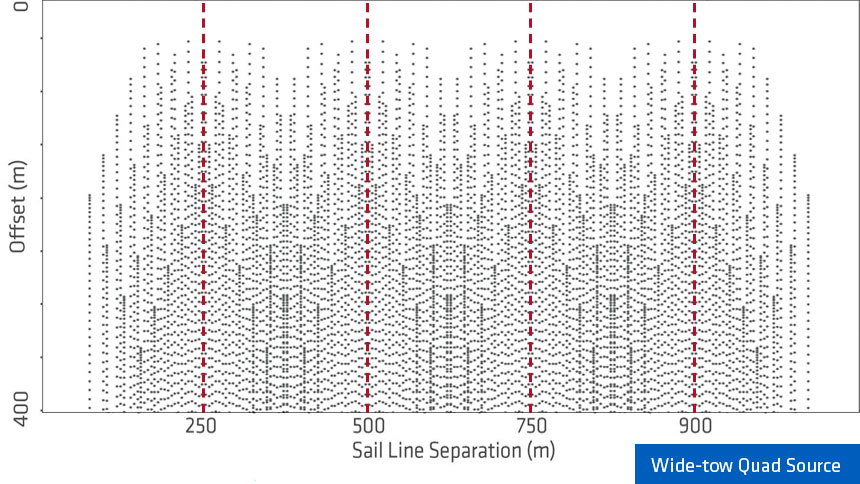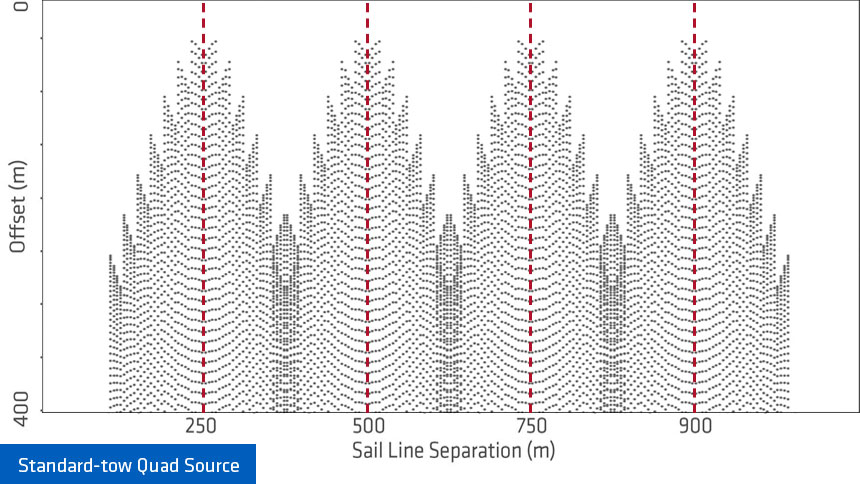The latest tailored acquisition solutions presented in this marine seismic edition of First Break highlight the key benefits of the PGS solutions:
- Multi-sources for efficiency and improved spatial sampling
- Wide-tow sources for accurate AVO analysis of shallow targets
- Wide-tow sources to reduce turnaround
- Longer offsets for reliable velocity model building
- Cost-effective multi-azimuth acquisition
Read the full paper ‘Redefining marine towed-streamer acquisition’
Wide-Tow Sources for Efficiency and Accurate AVO
Towing sources wider provides a smaller distance from source to outer streamer and can laterally extend data coverage. This can reduce turnaround and cost without sacrificing near-offset coverage.
Wide-tow sources can also deliver significantly improved near-offset coverage combined with dense spatial sampling. This is especially relevant for shallow targets in shallow water.
A comparison of a standard source set-up with a wide tow source configuration is shown in the figure below. The improvement in the near-offset coverage for shallow AVO analysis is clear.
Recently, PGS completed the Viking Graben GeoStreamer X survey, using a single vessel operation in the North Sea, successfully towing a 225 m wide source with triple arrays, with sources distributed very close to the streamer front ends.
A Two-in-One Solution - Accurate Velocity Models and High-Resolution Images
With smart source and receiver towing, PGS can offer a ‘2-in-1 solution’ delivering ultra-high-density data for imaging and at the same time a velocity survey, as acquired in the Barents Sea in 2018. The Hammerfest survey employed a high-density 16 x 56.25 m streamer spread with a triple-source set-up. Three of the 16 streamers were deployed with 10 km long streamer tails providing long offsets for FWI.
Read more about this novel configuration and the superior imaging results in our Barents Sea Case Study.
GeoStreamer X | A Fresh Multi-Azimuth Approach
Multi-azimuth acquisition improves illumination, multiple attenuation, and signal-to-noise ratio. The latest PGS multi-azimuth seismic concept, called GeoStreamer X, is flexible and can be tailored for any imaging challenge, which is particularly useful where 3D seismic data already exists. Unlike ocean bottom seismic techniques, such as OBN, in many geographical locations, only one vessel is required for multi-azimuth, improving efficiency and turnaround. For deeper targets, such as offshore Brazil, an alternative two-vessel GeoStreamer X configuration is proposed with a tailored solution that can deliver effective source-receiver offsets up to 20 km for FWI applications and superior velocity models.
Find Out More
Read the full paper ‘Redefining marine towed-streamer acquisition’, First Break November 2019.
Contact a PGS expert
Please contact a member of our AMME team for more information.

